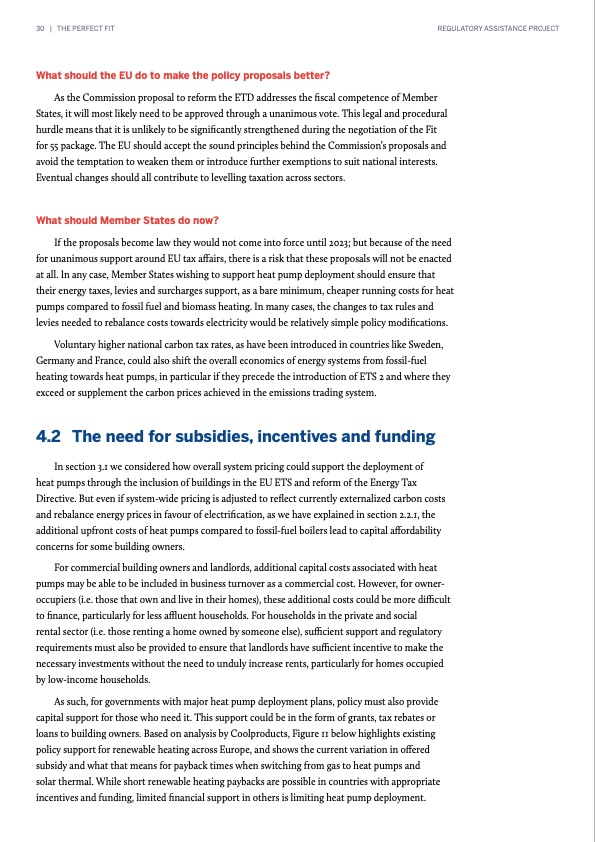
PDF Publication Title:
Text from PDF Page: 030
30 | THE PERFECT FIT REGULATORY ASSISTANCE PROJECT What should the EU do to make the policy proposals better? As the Commission proposal to reform the ETD addresses the fiscal competence of Member States, it will most likely need to be approved through a unanimous vote. This legal and procedural hurdle means that it is unlikely to be significantly strengthened during the negotiation of the Fit for 55 package. The EU should accept the sound principles behind the Commission’s proposals and avoid the temptation to weaken them or introduce further exemptions to suit national interests. Eventual changes should all contribute to levelling taxation across sectors. What should Member States do now? If the proposals become law they would not come into force until 2023; but because of the need for unanimous support around EU tax affairs, there is a risk that these proposals will not be enacted at all. In any case, Member States wishing to support heat pump deployment should ensure that their energy taxes, levies and surcharges support, as a bare minimum, cheaper running costs for heat pumps compared to fossil fuel and biomass heating. In many cases, the changes to tax rules and levies needed to rebalance costs towards electricity would be relatively simple policy modifications. Voluntary higher national carbon tax rates, as have been introduced in countries like Sweden, Germany and France, could also shift the overall economics of energy systems from fossil-fuel heating towards heat pumps, in particular if they precede the introduction of ETS 2 and where they exceed or supplement the carbon prices achieved in the emissions trading system. 4.2 The need for subsidies, incentives and funding In section 3.1 we considered how overall system pricing could support the deployment of heat pumps through the inclusion of buildings in the EU ETS and reform of the Energy Tax Directive. But even if system-wide pricing is adjusted to reflect currently externalized carbon costs and rebalance energy prices in favour of electrification, as we have explained in section 2.2.1, the additional upfront costs of heat pumps compared to fossil-fuel boilers lead to capital affordability concerns for some building owners. For commercial building owners and landlords, additional capital costs associated with heat pumps may be able to be included in business turnover as a commercial cost. However, for owner- occupiers (i.e. those that own and live in their homes), these additional costs could be more difficult to finance, particularly for less affluent households. For households in the private and social rental sector (i.e. those renting a home owned by someone else), sufficient support and regulatory requirements must also be provided to ensure that landlords have sufficient incentive to make the necessary investments without the need to unduly increase rents, particularly for homes occupied by low-income households. As such, for governments with major heat pump deployment plans, policy must also provide capital support for those who need it. This support could be in the form of grants, tax rebates or loans to building owners. Based on analysis by Coolproducts, Figure 11 below highlights existing policy support for renewable heating across Europe, and shows the current variation in offered subsidy and what that means for payback times when switching from gas to heat pumps and solar thermal. While short renewable heating paybacks are possible in countries with appropriate incentives and funding, limited financial support in others is limiting heat pump deployment.PDF Image | RAP Perfect Fit Heat Pump

PDF Search Title:
RAP Perfect Fit Heat PumpOriginal File Name Searched:
RAP-heat-pump-report-FINAL_2022_03.pdfDIY PDF Search: Google It | Yahoo | Bing
CO2 Organic Rankine Cycle Experimenter Platform The supercritical CO2 phase change system is both a heat pump and organic rankine cycle which can be used for those purposes and as a supercritical extractor for advanced subcritical and supercritical extraction technology. Uses include producing nanoparticles, precious metal CO2 extraction, lithium battery recycling, and other applications... More Info
Heat Pumps CO2 ORC Heat Pump System Platform More Info
| CONTACT TEL: 608-238-6001 Email: greg@infinityturbine.com | RSS | AMP |